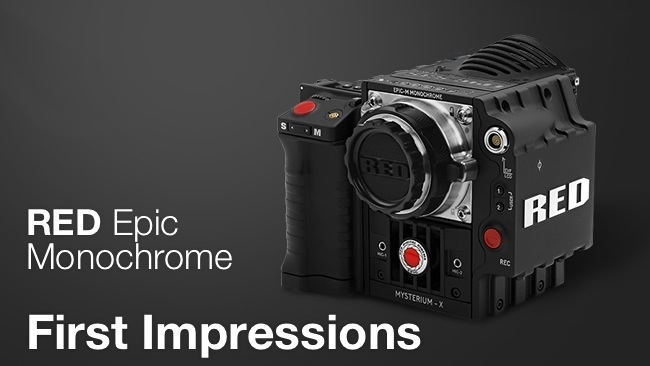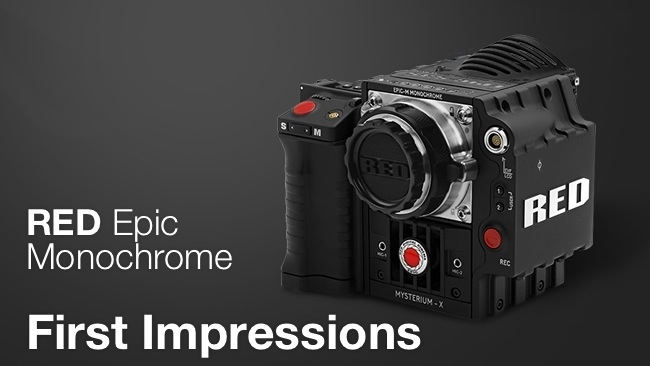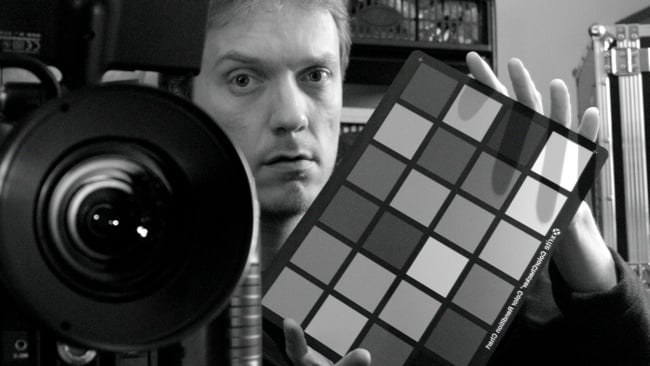
 Epic M Monochrome
Epic M Monochrome
We've been given a RED EPIC M Monochrome to use for a couple of weeks, lent to us by RED’s European headquarters in Pinewood Studios, West London. Why does this very high resolution black and white video camera even exist?
The whole point of this device is that it is a dedicated black and white camera; but it is so closely related to the standard colour version that most of what I write about the camera itself is going to be equally relevant to the system that gives a full colour output.
Citizen Kane
The potential for pretty pictures in black and white needs almost no introduction. Perhaps the most widely cited film of its type is Citizen Kane, which was photographed in a way that almost mocks the widescreen colour image with shallow depth of field that's currently in vogue. Kane was in 1.37:1, monochrome, and the filmmakers went to extreme lengths to keep everything in focus, which would have been tricky given the technology of the time. Gregg Toland, ASC's cinematography was nominated for the 14th Academy Awards – even the guy's most commonly used headshot is beautiful in a 1940s sort of way, and it's all in black and white. Toland died at the age of only 44 in 1948, but I'm sure there were moments on Kane, and other movies he shot in a similar style, where he'd have gladly eaten his light meter for film stock as fast as an Epic.
With films like The Artist equally prominent more recently, it's nice to have the option to shoot true monochrome with the same conveniences we're used to with more modern cameras.

If you search, you can find numerous tests that that show the main difference: the mono camera is visibly much sharper than any of the RGB channels from its colour brother. That’s not really surprising, because there is a one-to-one relationship between the pixels on the sensor and the output of the camera. It does tend to confirm the suspicions held by those of us who always felt that Bayer images were likely to be significantly less sharp than fully populated RGB. But with the Epic already 5K and a sensor upgrade to six already announced, it doesn’t really seem to be about resolution anymore. The success of the much lower resolution Alexa suggests much the same thing.
Perhaps because of this, I’m not inclined to take too much notice of harebrained schemes to use a sequential mechanical filter scheme, which would give the benefit of the extreme sharpness of a monochrome sensor and, of course, full colour. The circumstances under which the extra resolution – compared to a colour Epic – would actually be useful are very rare and the postproduction effort probably not worthwhile. A while ago I might have suggested that it’d make a good light input device for a film scanner, but that, too, is likely to be a niche interest from here out.
Why?
Why, then, is the Monochrome EPIC necessary at all?
The short answer is that it probably isn’t to most people: it will always be a niche product. But as an end in itself, there is potentially no better way to acquire monochrome moving images.
The slightly more complete answer is that RED made the EPIC Monochrome because David Fincher (Alien 3, Fight Club, The Curious Case of Benjamin Button, Social Network, The Girl with the Dragon Tattoo) asked them to (for a production they apparently aren’t allowed to name).
They were able to do it because the research and development required was fairly limited: don’t put the colour filter array on the front, tweak the infra-red and low-pass filtering to suit, and make a few software changes. OK, on an embedded system like this, “a few software changes” is a phrase that’ll drain the colour from the lead engineer’s face because there is no such thing as a “minor change” to code of this type and because it’s a mistake to believe there is. Even so, a mono Epic is not something I suspect took them too many months.
Needless to say, the gritty engineering details are confidential, but we do know that the Red Rocket card, which is a hardware decoder that helps out with decompression (though not debayering), is not supported with mono Epic footage. This suggests, reasonably enough, that the way it’s stored is somewhat different from the four separate images (red, blue, and two green) of a conventional redcode frame. Technical minutiae aside, there’s no news as to whether the Rocket accelerator ever will be supported or if this is some sort of fundamental hardware limitation. Certainly if they’re storing the entire greyscale image as one enormous frame, that would be beyond the sort of dimensions for which most JPEG-2000 decoders, which are chiefly designed to work as part of digital cinema playback servers, are specified.
One engineering aspect that could do with improvement: the fan's a bit noisy.

Pictures
It's difficult to be specific about the pictures at this point because, on displays of a reasonably conventional resolution, it looks like an Epic, only black and white. FLUT, gamma and monitoring options operate as normal. This isn't necessarily a bad thing, and at first glance it seems to retain the perhaps slightly abrupt highlight response that other Red cameras have exhibited. At their offices at Pinewood I was told “we believe in resolution”, which is fine, and having to all intents won that battle it would be interesting to see what they're going to concentrate on next.
We'll be testing the camera over the next two weeks and will give you a more detailed account of it after that - including some video.
Tags: Production


Comments